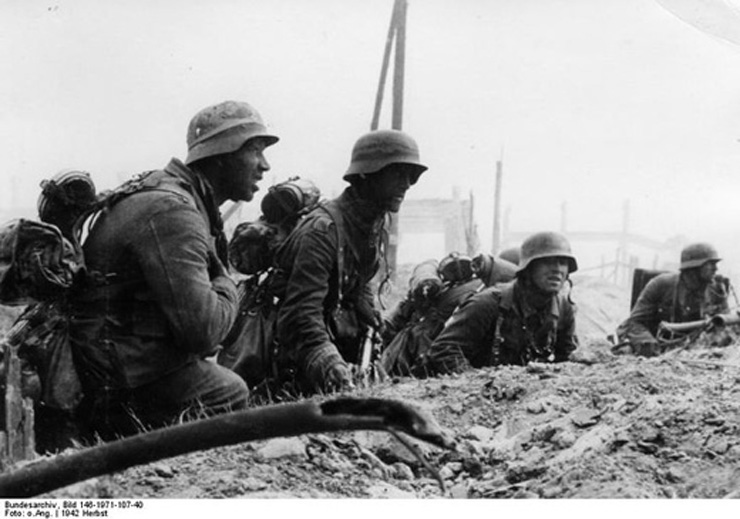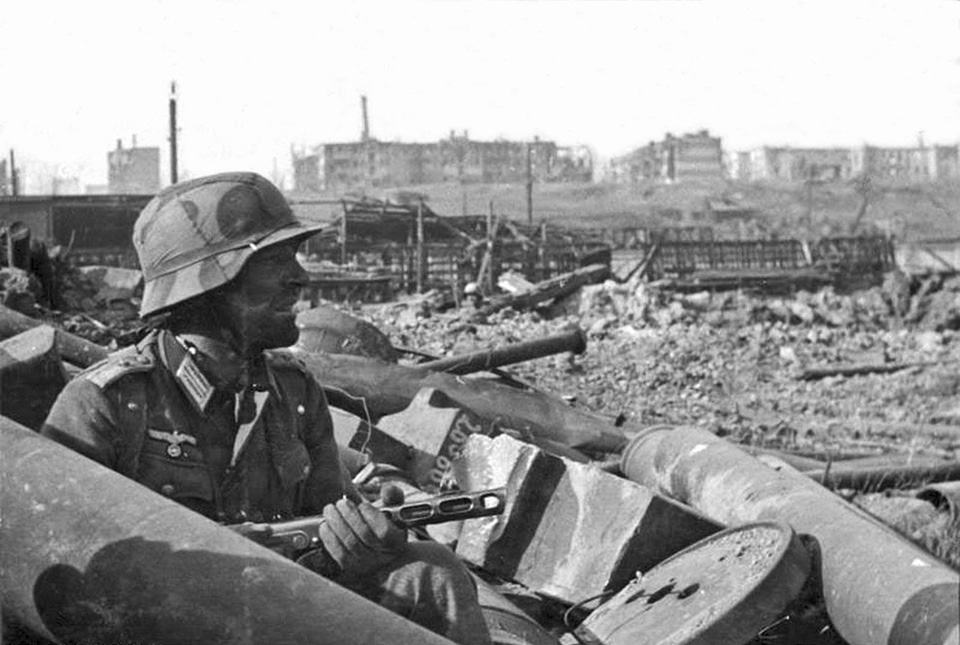Air Operations, Aleutians
Following a sighting by a Patrol Wing 4 PBY, 1 28th Composite Bomb Group B-17, 6 B-26s and 4 P-38s attack Kiska and mount a low-level bombing attack against 2 Japanese destroyers. 1 destroyer is sunk and the other severely damaged. 1 B-26 is lost.
[Air Operations, Bismarcks
V Bomber Command B-17s attack the airfields in the Rabaul area.
[Air Operations, Europe
BOMBER COMMANDDaylight Ops:
- 6 Mosquitos bomb a factory at Hengelo; 6 Bostons are sent to Le Havre, but turn back because of the weather; there are no losses.
- 23 Wellingtons and 11 Stirlings lay mines off the Biscay ports; there are 5 OTU sorties.
- 2 Wellingtons and 2 Stirlings are lost in the mine-laying operations.
Air Operations, Libya
Although many USAMEAF B-17s and B-24s sent to attack Benghazi harbor must abort because of bad westher, several B-24s are able to attack the target.
[Air Operations, New Guinea
V Bomber Command B-25s and A-20s attack numerous targets in the Owen Stanley Mountains along the Mambare River.
[Air Operations, Solomons
- Cactus Air Force SBDs, P-39s and P-400s mount 7 ground-attack missions against Japanese Army supply dumps in western Guadalcanal.
- V Bomber Command B-17s attack the airfield at Buin and other targets in the northern Solomons.
Aleutian Islands
American aircraft sink the Japanese destroyer Oboro.
[Battle of the Atlantic
- U-353 is the second of two U-boats sunk following convoy SC-104. The destroyer HMS Fame followed up a radar contact, rammed the U-boat, then engaged with gunfire and depth charges.
- The US freighter Winona, in a convoy bound for Rio de Janeiro, is torpedoed by U-160 with injuries to 1 of the 42 crewmen and 2 of the 15 Armed Guard sailors.
| Class | Type VIIC |
| CO | Oberleutnant zur See Wolfgang Romer |
| Location | North Atlantic |
| Cause | Ramming/gunfire/depth charge |
| Casualties | 6 |
| Survivors | 33 |
Eastern Front
SOUTHERN SECTORFighting in the factories reach a peak as the Luftwaffe launches a massive raid. Heavy fighting follows as German infantry attacks south from the Tractor factory toward the Barrikady, striking the 84th Tank Brigade hard. Amid furious fighting, the brigade holds the Germans on Tramvaynaya Street. In the Tractor factory, the 37th Guards is down to just 200 men but fight on.
|
|
Guadalcanal
The Japanese begin moving along the narrow trail from their Kokumbona assembly area toward their proposed attack positions east of the Lunga River. The movement of troops and equipment into place will be a long, slow process as there is no transport of any kind. Everything has to be hand-carried. The trail is narrow, mostly single-file. Ropes are used to scale some cliffs, and to pull artillery pieces, machine guns and mortars along the trail. Rain falls most of the time and because of the conditions many guns are abandoned along the line of march. Japanese artillery shelling of the Lunga perimeter increases in volume and accuracy.
US patrol craft attack the enemy coastal positions from Kokumbona to Cape Esperance. The number of operational aircraft increases to 66 after the arrival of 20 F4Fs and 12 SBDs. The seaplane tender MacFarland (AVD-14) is seriously damaged by enemy aircraft in Sealark Channel but is salvaged by her crew.
The destroyer-seaplane tender McFarland (AVD-14) arrives at Guadalcanal carrying 12 torpedoes for the non-existant torpedo bombers, crates of 37-mm ammunition for Gen Vendegrift's guns and above all 40,000 gallons of aviation fuel for Henderson Field. At 1700 they are alerted about a possible submarine in the area. Lt-Cmdr John C. Alderman, captain of the McFarland (AVD-14) decides to move out for the night before the unloading is complete. 50 minutes later 9 Japanese dive bombers attack McFarland (AVD-14). The ship's gunners shoot down 1 and damage another, but the planes blow up the gasoline barge and put a bomb into the ship's fantail. Damages are brought under control as the ship heads for the Tulagi harbor saving precious aviation fuel in the tender. Several times each day R4D transport planes bring drums of fuel from Espritu Santo. The Submarine Amberjack (SS-219( is loaded with 9,000 gallons of gas and 10 tons of aerial bombs also makes the voyage.
32 US aircraft land at Henderson Field giving the Marines a total of 66.
The headquarters of the Japanese 17th Army draws up the dispositions for the great offensive against the American perimeter at Lunga. The operation is scheduled to begin on the 18th.
The American destroyer Meredith (DD-434) is sunk by an enemy torpedo plane near San Cristobal Island.
During the night the Japanese cruisers Maya and Myoko fire 1,500 shells in to the American defensive perimeter, concentrating on Henderson Field.
During the night Pearl Harbor's radio intelligence team intercepts messages saying planes from the Japanese carriers Hiyo and Junyo have flown to Buka and will attack Guadalcanal morning of 10/17.
[India, Home Front
A cyclone in the Bay of Bengal kills about 40,000, most of them in the area south of Calcutta. The destructive force severely cripples transportation and logistics for the Burma front.
[Indian Ocean
US submarines begin mining the Gulf of Siam on the approaches to Bangkok.
[Madagascar
The British forces take Ambositra, 140 miles south of Tananarive.
[Solomons
Aircraft from the carrier Hornet (CV-8), which is patrolling the waters south of Guadalcanal, raid Japanese supply bases on Rekata Bay, Santa Isabel. Japanese arms and ammunition depots near Tassafaronga are destroyed. On Guadalcanal the Japanese are preparing for a major attack by an increasing bombardment of the American positions.
[
